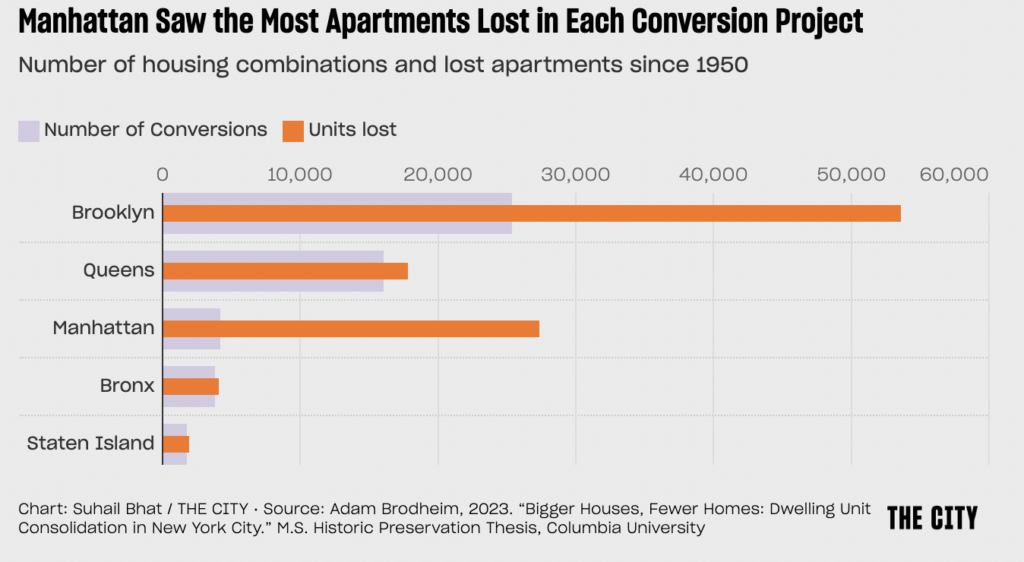New York lost more than 100,000 homes due to the combination of smaller, more affordable apartments into larger, more luxurious homes
When rich people can’t buy new luxury housing, they buy up, and combine small apartments to create larger homes.
This is a negative sum game: the number of housing units gained by high income households is fewer than the number
If you’re worried about gentrification and displacement, this is a vastly larger problem than new construction–which has been repeatedly shown to lower rents and create more housing opportunities for lower income households.
The obsession with fighting new development reflects a profound cognitive bias in thinking about housing: we equate new units with unwanted change, while ignoring the effectively invisible destruction of existing units by upscaled combinations.
New York Lost 100,000 Homes to Consolidation
A new study reported in The City finds that over the past several decades, the number of homes in New York has declined by more than 100,000 as smaller apartments have been consolidated into larger homes. The data come from a thesis prepared by Adam Brodheim of Columbia University.
The effect of unit consolidation has been to partially or totally offset the positive supply effects of new construction. In some neighborhoods, the number of housing units lost to these combinations dwarfs new construction. In New York, the largest number of units have been lost in Manhattan and Brooklyn.
Combinations and Gentrification
The demand for consolidation comes from higher income families who want to live in the city but can’t find units that are large enough to accommodate their needs and income. In a very real sense, the failure to build enough new luxury housing means these higher income households don’t go away, they outbid multiple middle and lower income households for these units.
Do each of these brownstones have four apartments, or only one? (Flickr: Sharona Gott)
Building more high end housing keeps those with high incomes from moving down market and out-bidding those with less income for the existing housing stock, we still hear this argument. For remaining doubters, have a look at Noah Smith’s thought experiment, asking what we think would happen to housing prices if we suddenly demolished 10,000 units of expensive housing.
This study confirms exactly the Smith’s thought-experiment posed by economist Noah Smith some years ago: The households don’t disappear; they outbid people with less income for the housing units that remain. Limiting supply doesn’t reduce demand, especially by high income households. The demand is there whether you supply new larger, luxury units or not, and with no other place to go, it spills over into other parts of the housing market, to the detriment of everyone else lower on the ladder.
And in New York, with these high end-remodeling combinations, the result is actually a negative sum game. High income households don’t simply displace lower income households one for one: each new combined unit to house one higher income household displaces multiple households with lower incomes.
If you are concerned about gentrification, you ought to be deeply concerned about these conversions, rather than new construction. While the knee jerk solution might be to try and block combinations, that misses the fact that the underlying problem is that there are simply too few units and too little space compared to the number of people who want to live in cities.
(We see the same thing happening in Silicon Valley, where an otherwise unremarkable ranch house from the 1950s commands a multi-million dollar price tag–because its so difficult to build new housing there).
An invisible process produces cognitive bias
The process is largely invisible: Unlike new buildings, which are obvious, public and highly regulated, the combinationof apartments occurs out of public sight, behind closed doors and with minimal regulatory scrutiny:
. . . three previously multi-unit brownstones have been converted into single-family homes over the years — but you’d never know it unless you spotted a construction permit, or noticed multiple buzzers replaced by one doorbell, he said.
“From the perspective of most people on the street, they’re not noticing that seven fewer families are able to live on this block … and this happens all the time,” Brodheim told THE CITY. “Unlike new buildings, which have to go through this huge gauntlet of, often, public opposition to create new units, here you’re able to get rid of apartments without anyone noticing.”
As we’ve noted in our analysis of gentrification, there’s a profound cognitive bias in understanding neighborhood change. Our research shows that there’s been a dramatic increase in concentrated poverty in US cities, and that poor neighborhoods tend to hemorrhage population. Fewer than one in twenty high poverty US neighborhoods gentrified over four decades; far more commonly high poverty neighborhoods spread and lost population. But these processes occur slowly, over decades, and are imperceptible or simply unperceived by most residents. In contrast, new construction is obvious, and people understandably associate it with neighborhood change. Our attention is naturally drawn to those places where an urban transformation is happening the most rapidly; new investment and construction are much more noticeable than the imperceptible processes of neighborhood decline.




